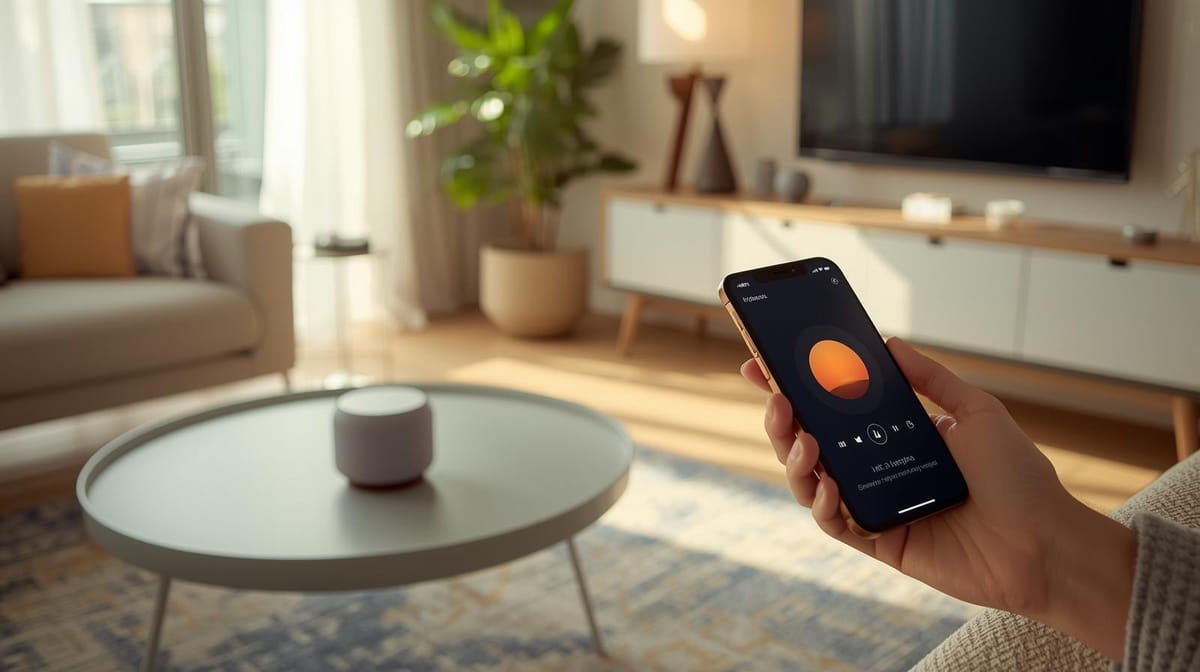Transform Your Apartment Into a Smart Home: The Complete 2025 Guide

Living in an apartment doesn't mean you can't enjoy the convenience and efficiency of a smart home. Whether you're renting or own your space, converting your apartment into a smart home is easier and more affordable than ever. As someone who's tested dozens of smart home devices over the years, I've learned exactly what works for apartment living—and what doesn't.
The beauty of modern smart home technology is that most devices are completely renter-friendly, requiring no permanent installation or modifications to your space. You can take everything with you when you move, making this a smart investment for any living situation.
Let me walk you through exactly how to transform your apartment into an intelligent, connected space that responds to your needs.
Why Convert Your Apartment to a Smart Home?
Before we dive into the how-to, let's talk about why this matters. A smart apartment offers:
- Energy savings of 10-25% on your utility bills through automated climate and lighting control
- Enhanced security with smart locks, cameras, and sensors that alert you to any unusual activity
- Convenience that saves you time daily—voice control everything from your lights to your coffee maker
- Increased comfort with automation that adapts to your routines and preferences
- Peace of mind when you're away, with remote monitoring and control of your space

Step 1: Start With a Smart Hub (Your Central Command)
Every smart apartment needs a brain—a central hub that connects and controls all your devices. This is your foundation, so choose wisely.
Recommended: Amazon Echo (4th Gen)
The Echo (4th Gen) is my top recommendation for apartment dwellers. It's compact, powerful, and supports virtually every major smart home protocol including Zigbee, Thread, and Matter. Alexa's voice recognition is excellent, and the built-in smart hub means you won't need additional hardware for most devices.
Why it's perfect for apartments: No installation required, sleek design that fits any décor, and exceptional third-party device compatibility.
Alternative Option: Google Nest Hub (2nd Gen)
If you're already invested in the Google ecosystem, the Nest Hub offers a touchscreen interface that's incredibly useful for viewing cameras, setting timers, and following recipes. Google Assistant excels at answering questions and managing your calendar.
Step 2: Intelligent Lighting (The Easiest Win)
Smart lighting is the fastest way to transform your apartment's ambiance and functionality. No electrician needed—just screw in bulbs and connect them to your app.

Recommended: Philips Hue White and Color Starter Kit
This kit includes four color-changing bulbs and a bridge hub. You can set schedules, create scenes for different moods, and sync lights with your entertainment. I've been using Hue bulbs for three years, and they've never failed me.
Setup time: 10 minutes
Installation: Zero—just replace your existing bulbs
Budget-Friendly Option: Govee Smart LED Bulbs
If Hue is outside your budget, Govee offers excellent value. These WiFi bulbs don't need a separate hub and work great with Alexa and Google Home. The colors are vibrant, and they're perfect for accent lighting.
For Renters: Smart Plugs
TP-Link Kasa Smart Plug Mini (4-Pack)
Can't replace bulbs? Smart plugs let you control any lamp remotely. These compact plugs don't block adjacent outlets and work flawlessly with voice commands. I use these for floor lamps, string lights, and even my coffee maker.
Step 3: Climate Control That Saves Money
Heating and cooling often account for 50% of apartment energy costs. Smart thermostats pay for themselves within a year.

Recommended: ecobee SmartThermostat with Voice Control
The ecobee is my favorite smart thermostat because it includes remote sensors that detect occupancy and temperature in different rooms—perfect for apartments where one room might be warmer than others. It also has built-in Alexa, so it doubles as a voice assistant.
Important for renters: Installation takes about 30 minutes and is completely reversible. Just keep your old thermostat to reinstall when you move.
Alternative: Wyze Thermostat
For budget-conscious apartment dwellers, the Wyze Thermostat offers 90% of the features at half the price. It learns your schedule and adapts automatically. The only drawback? No remote sensors, but for most apartments, that's not a deal-breaker.
Step 4: Security Without Drilling Holes
Security is crucial, especially if you're on the ground floor or have concerns about package theft.

Recommended: Ring Video Doorbell (Battery-Powered)
The battery-powered Ring doorbell mounts with adhesive strips or removable screws—no wiring required. It captures crisp 1080p video, has two-way talk, and motion detection that actually works. You'll see and speak to visitors from anywhere.
Rental-friendly feature: The mounting bracket removes cleanly, leaving minimal marks.
Smart Lock: Wyze Lock Bolt
This ingenious lock mounts on the inside of your door without replacing any hardware—your landlord will never know it's there. It works with your existing deadbolt and provides keyless entry via keypad or smartphone. I tested this in my own apartment, and installation took 10 minutes with just a screwdriver.
Indoor Security: Blink Mini Camera (2-Pack)
For monitoring interior spaces, Blink Mini cameras are affordable, reliable, and wire-free capable with the optional battery pack. Place them to watch your front door from inside, keep an eye on pets, or monitor valuable items.
Step 5: Voice Control Everything
Once you have smart devices, voice control becomes addictive. Here are additional Alexa/Google Home compatible devices that complete the smart apartment experience:

Smart Blinds: SwitchBot Blind Tilt
These motorize your existing blinds without replacement. They're solar-powered, whisper-quiet, and work on schedules. Wake up to natural sunlight or close blinds automatically at sunset.
Coffee Maker Integration: Kasa Smart Plug Power Strip
Individual outlet control means you can schedule when specific devices turn on. Your coffee maker starts brewing right before you wake up, your phone charges during off-peak hours, and phantom power draw is eliminated.
Air Quality: Levoit Core 400S Air Purifier
This smart air purifier monitors air quality in real-time and adjusts automatically. Control it via voice or app, check your air quality remotely, and breathe easier. Especially valuable in apartments where you can't control ventilation.
Step 6: Entertainment and Ambiance
Transform your apartment into an entertainment paradise with these additions:

Govee TV LED Backlights with Camera
These LED strips mount behind your TV and use a camera to match the colors on your screen, creating an immersive viewing experience. They're addressable, so effects flow across the entire strip. Gaming and movies become incredibly engaging.
Fire TV Stick 4K Max
Even if your apartment has a smart TV, the Fire TV Stick 4K Max provides faster performance, better voice control integration, and acts as another smart home controller. It's the fastest streaming stick Amazon makes.
Step 7: Smart Kitchen Upgrades
The kitchen is often overlooked in smart home conversions, but there's huge convenience to be gained here.
Instant Pot Duo Plus Smart WiFi
Control your pressure cooker remotely, receive alerts when your meal is ready, and access hundreds of guided recipes via the app. I use this weekly—it's genuinely useful, not a gimmick.
Smart Kitchen Scale: Greater Goods Nourish
This smart scale tracks nutritional information automatically and syncs with popular health apps. Perfect for meal prep and portion control.

Creating Automation Routines (Where the Magic Happens)
Having smart devices is great, but automation routines are where your apartment becomes truly intelligent. Here are routines I use daily:
"Good Morning" Routine:
- 6:30 AM: Bedroom lights gradually brighten to 50%
- 6:45 AM: Coffee maker turns on
- 6:50 AM: Weather and news briefing plays on Echo
- 7:00 AM: Thermostat adjusts to daytime temperature
- Blinds open to natural light
"Leaving Home" Routine:
- All lights turn off
- Thermostat enters eco mode
- Security cameras activate
- Smart plugs for non-essentials turn off
- Door lock status check notification
"Movie Time" Routine:
- Living room lights dim to 20%
- TV backlights activate
- Do Not Disturb mode on phone
- Ambient lighting switches to warm colors
"Bedtime" Routine:
- All lights except bedroom turn off
- Bedroom lights dim to 10% warm white
- Thermostat lowers temperature
- Door locks verify
- White noise machine or sleep sounds activate

Money-Saving Tips and Common Mistakes
After testing smart home gear in apartments for years, here's what I've learned:
Start Small: Don't buy everything at once. Begin with lighting and a hub, then expand monthly. This spreads the cost and lets you learn what you actually use.
Check Compatibility: Always verify devices work with your chosen ecosystem (Alexa, Google, or HomeKit) before purchasing.
Avoid These Mistakes:
- Buying devices that require professional installation
- Choosing products incompatible with your hub
- Installing too many apps (stick to one ecosystem)
- Forgetting to consider WiFi coverage
WiFi Is Critical: Smart homes are only as reliable as your WiFi. If you have dead zones, consider:
TP-Link Deco Mesh WiFi System (Deco M5)
This affordable mesh system eliminates WiFi dead zones and handles dozens of connected devices simultaneously. Essential for apartments with thick walls or multiple rooms.
Estimated Costs and Prioritization
Here's how to budget your smart apartment conversion:
Essential Starter Package ($250-350):
- Smart hub/speaker
- Smart bulb starter kit
- Smart plugs (4-pack)
Security Addition ($150-250):
- Video doorbell
- Indoor camera
- Smart lock
Comfort Upgrade ($200-300):
- Smart thermostat
- Smart blinds
- Air purifier
Full Transformation ($800-1,200):
- Everything above plus entertainment, kitchen, and mesh WiFi

Troubleshooting Common Issues
Devices Won't Connect: Ensure you're on the 2.4GHz WiFi band (most smart devices don't support 5GHz). Check if your router has client isolation enabled—disable it for smart home devices.
Routines Aren't Triggering: Voice assistants need explicit permissions. Review device permissions in your Alexa or Google Home app.
Slow Response Times: Too many devices can overwhelm budget routers. Upgrade to mesh WiFi or a router designed for IoT devices.
Final Thoughts
Converting your apartment into a smart home is one of the best quality-of-life upgrades you can make. Start with the basics—a hub, smart lighting, and a smart plug or two—then expand as you discover what enhances your daily routine.
The devices I've recommended are all products I've personally tested and would buy myself (in fact, I own most of them). They're reliable, renter-friendly, and won't break the bank.
Remember: the goal isn't to automate everything possible, but to automate the things that genuinely make your life easier. Smart home technology should disappear into the background, working seamlessly to save you time, money, and hassle.

Affiliate Disclosure
Important: This article contains affiliate links to Amazon products. When you click on these links and make a purchase, I may earn a small commission at no additional cost to you. These commissions help support my work and allow me to continue testing and reviewing smart home products.
I only recommend products I have personally tested or would confidently use in my own home. All opinions expressed in this article are my own and are not influenced by affiliate partnerships. Your trust is important to me, and I'm committed to providing honest, unbiased recommendations.
Thank you for supporting this content by using these links!



